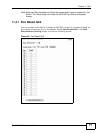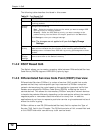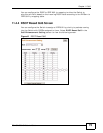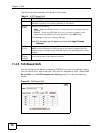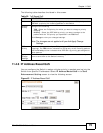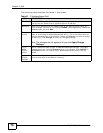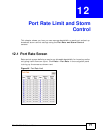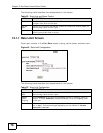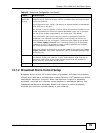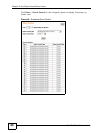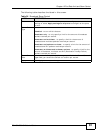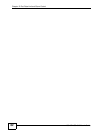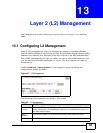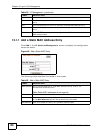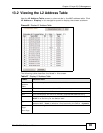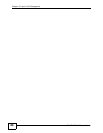
Chapter 12 Port Rate Limit and Storm Control
GS-1524/GS-1548 User’s Guide
79
12.1.2 Broadcast Storm Control Setup
Broadcast storm control limits the number of broadcast, multicast and unknown
unicast (also referred to as Destination Lookup Failure or DLF) packets the Switch
receives per second on the ports. When the maximum number of allowable
broadcast, multicast and unknown unicast packets is reached per second, the
subsequent packets are discarded. Enable this feature to reduce broadcast,
multicast and unknown unicast packets in your network.
Tokens
Added Per
Interval
The Switch uses a “Token Bucket” algorithm to limit the outgoing rate on
the ports and to limit the largest amount of packets that can leave the port
in any one instance.
In this algorithm each “token” represents an allowed amount of bandwidth
to be sent out on the port.
The “bucket” holds the tokens. In other words, the number of tokens in the
bucket represents the maximum allowed bandwidth to go out on the port.
The size of the bucket is specified by the “burst size” (see below).
Every time traffic goes out on the port, tokens (representing used up
bandwidth) are removed from the bucket, thus limiting the amount of
traffic allowed to go out on the port. Tokens are also added to the bucket
every Token Update Interval, thus resetting the amount of bandwidth
allowed to go out. If the bucket is empty, the data packets are dropped
until more tokens are added to the bucket.
Select the number of tokens that should be added to the bucket per Token
Update Interval. Each token represents .5 bit in bandwidth allowed to go
out on the port.
Burst Size The burst size specifies the maximum amount of traffic that can be allowed
out the port at any one instance. In the “Token Bucket” algorithm this is
referred to as the size of the bucket as this value limits the number of
tokens that can accumulate in the bucket.
Apply Click this to save your changes to the Switch.
Table 23 Rate Limit Configuration (continued)
LABEL DESCRIPTION



